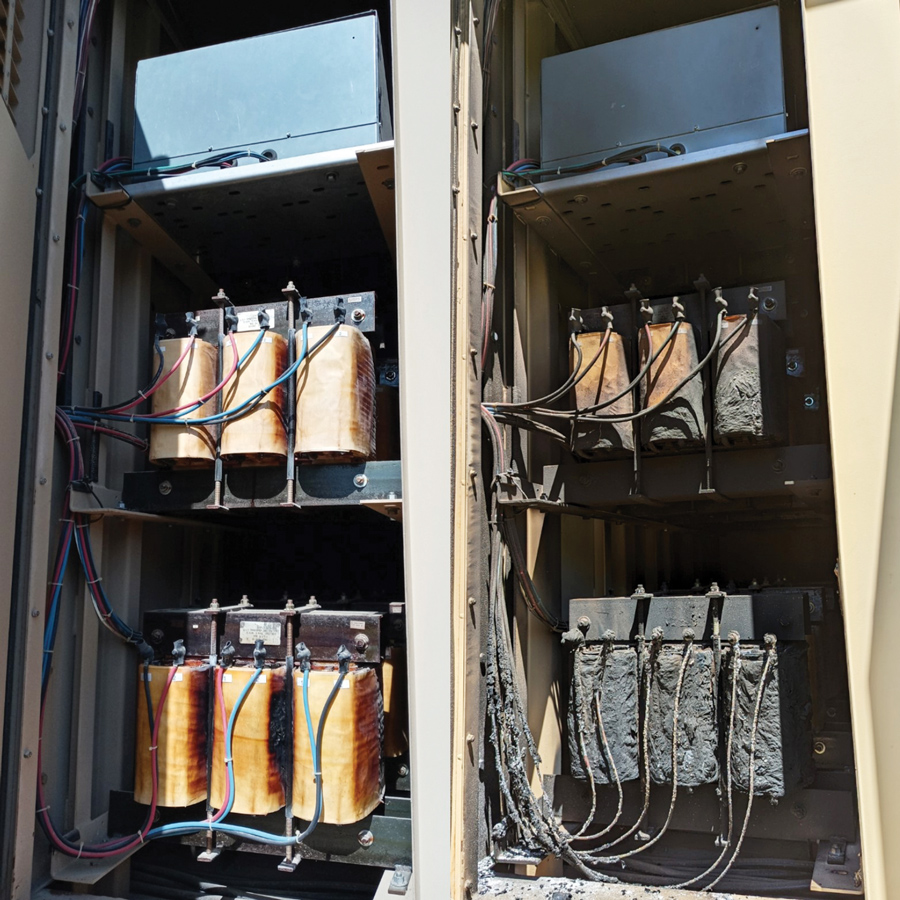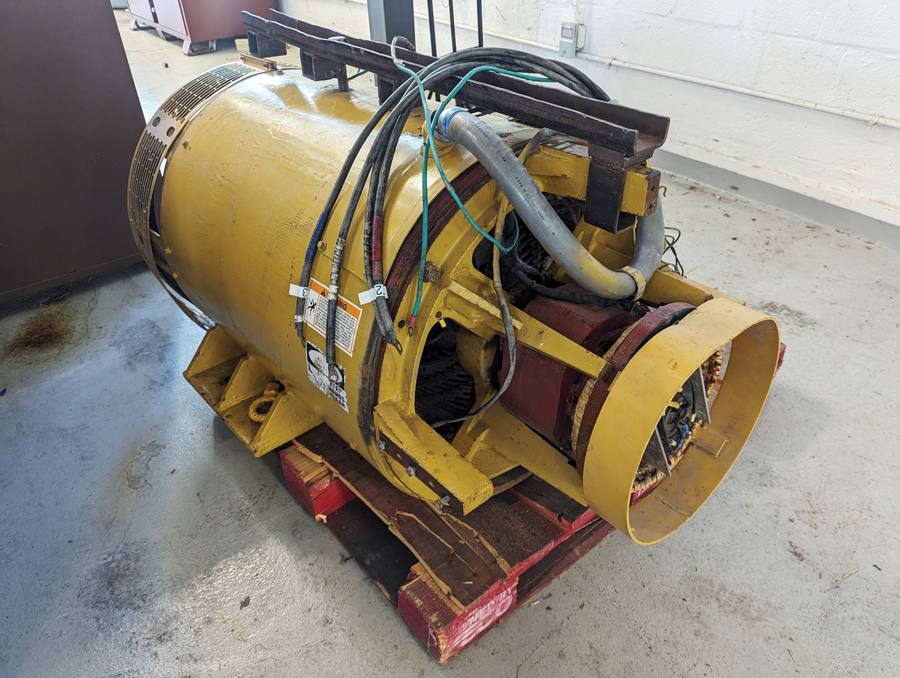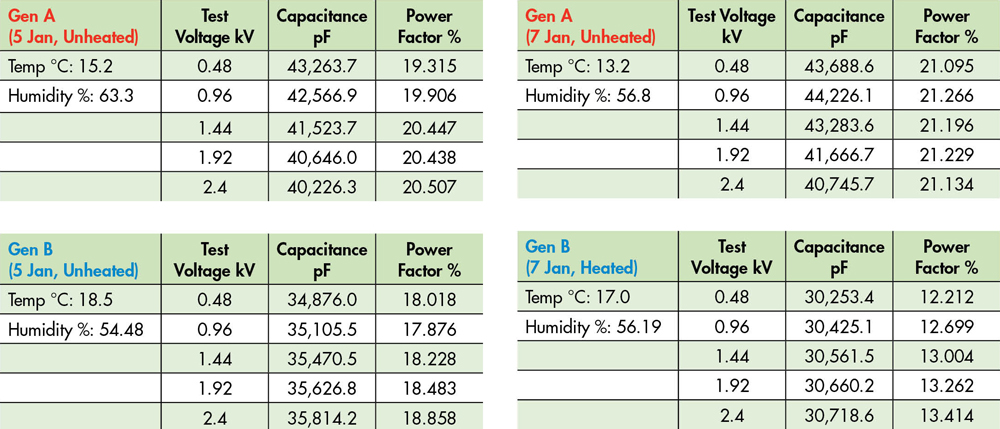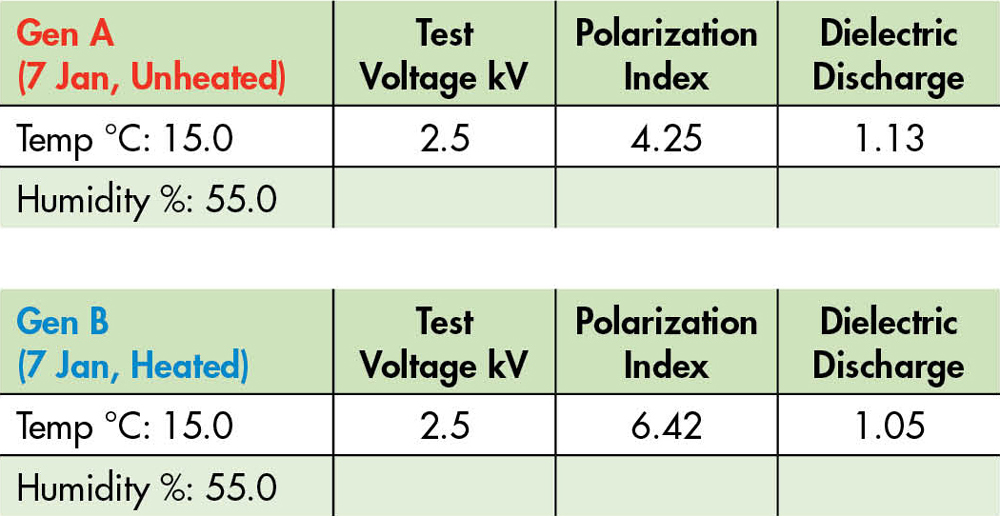Equipment underutilization is, by implication, an underdiscussed subject. I am all too familiar with this phenomenon, e.g., relays with useful but unprogrammed protective functions, calibrated test equipment that rarely sees the light of day, fully functional battery chargers next to pallets of long-deceased 12 V valve-regulated lead–acid batteries (VRLAs), etc.
This negligence is no less true of rotating machines, where inexpensive accessories meant to prolong the life of motors and generators frequently go unused. This is especially the case with anti-condensation heaters, which despite their diminutive status are critical components of machine longevity.
With a few notable exceptions in electrical applications, water is a contaminant. As stated in a Gund Company (2023) white paper:
Water in the form of condensed water vapor (moisture) on the surface of solid insulation attracts airborne dust that allows for the dissolution of corrosive gaseous contaminants, which promotes the ionization of water. The presence of a significant amount of ionized water molecules reduces surface resistivity and shortens creepage distance. Also, the dipole nature of a water molecule promotes polarization (dielectric dissipative loss) and reduces dielectric withstand…if entrapped in a significant amount.
FIGHTING CONDENSATION
The function of anti-condensation heaters, often called space heaters, is to keep equipment temperature above the dew point. In motors and generators, this means when they are de-energized. The dew point is the temperature to which air must decrease in order to be saturated with water vapor and is a function of relative humidity and air pressure. If the temperature of motor windings or switchgear insulation is above the dew point, then no condensation will form. A temperature rise of at least 5° C above ambient is usually sufficient to keep windings dry. Such a buffer is necessary, especially for equipment in places with 100% relative humidity. At this humidity ambient temperature equals the dew point.
Not all rotating machines are equally vulnerable to condensation. As Nidec Motor Corporation (2024) states:
In climates and applications where unusually high relative humidity exists, warm humid air contacting a cold motor will cause condensation that can lead to accelerated deterioration of motor parts. Condensation does not exist while the motor is running because the heat generated by the motor keeps the motor dry. However, when the motor is shut down, condensation starts to form; the longer the idle period, the more pronounced the rate of deterioration.
This is why rotating machines operating intermittently are more vulnerable than rotating machines operating continuously. It also explains why most heater circuits are designed to activate when motors turn off and deactivate when motors turn on. They are simple circuits, usually accepting 120 V or 230 V, and massively underappreciated.
Noah Bethel at PdMA stated in 2007 that simply keeping heaters on may double the life of a motor. That is a profound claim if true. Imagine extending the life of a critical asset generator from 25 to 50 years with such a simple fix. That’s a steal, particularly when you realize that these heaters cost a few hundred dollars, or even less, while catastrophic motor and generator failures can cost millions or have national security implications.
I once did a post-mortem on a load bank that suffered a fire that started at one of its 75 kVAR reactors (Figure 1). This load bank was operated very occasionally, was exposed to outdoor elements for years including routine water ingress, and was equipped with heaters that were never activated. The total cost of the repairs was $22,086.57. The cost of one of the 120 V 500 W heaters in the reactor compartment: $64.94. In hindsight, it’s reasonable to hypothesize that years of moisture intrusion was a major contributing factor to its demise.

ASSESSING GENERATOR HEATERS
In 2023, I ran a series of insulation integrity tests on two fairly new, identical, intermittently operated 4.16 kV synchronous generators (Figure 2): Gen A and Gen B. These units had nearly exact kWh and were located outside in a sandy, windy desert. The weather before and during testing was marked by decent rain and higher-than-normal relative humidity. My goal was to verify how saturated the generator insulation had become, observe how effective the installed space heaters were in reversing this process, and demonstrate how much moisture affected the test results.

On January 5, 2023, I ran power factor tip-up tests on Gen A and B stator winding insulation, starting at 20% of the generator phase-to-ground voltage rating (2.4 kV) and increasing the test voltage in four 20% increments up to 100%. I then activated the heater circuit only on Gen B for approximately 12 hours, then repeated the tip-up tests on January 7. The results were as follows:

My first impression was incredulity: 21% power factor is an extremely high number for any power equipment, let alone a medium-voltage generator. But repeated tests and considering the weather during the three-day testing period, which was defined by uncharacteristic rain and relatively high humidity for an otherwise extremely dry, dusty wasteland, gave the data plausibility. Additionally, all of the equipment at this site, inside and out, was covered in a thin layer of fine sand. Pure water has a high resistivity, but if mixed with the conductive elements or molecules typically found in sand such as aluminum, iron, or salts, it will make a relatively conductive fluid and create electrochemical reactions that attack insulation (Murashko, 2010).
The data clearly showed a patent decrease in power factor and capacitance in Gen B after heating, whereas those parameters in Gen A rose ever so slightly. Why water ingress raises insulation power factor is well-understood. Power factor is a ratio of resistive current IR to total current IT (Figure 3). Resistive current IR and capacitive current IC are parallel constituents of total insulation current (IT = √(IR2 + IC2)).

- As water coats surfaces, enters into equipment capillaries, and penetrates insulation, insulation resistance drops (Combined Cycle Journal, 2024).
- As insulation resistance drops, resistive current increases, thereby raising the power factor ceteris paribus as well as the probability of ground faults once the equipment is energized.
- If a heater is used to evict moisture from the insulation, insulation resistance increases, resistive current falls, and power factor decreases.
The effect of moisture on capacitance is less well-known. The insulation between disconnected stator windings and the grounded frame of the generator acts as a dielectric between two unbonded conductors. This is the definition of a capacitor. The best mathematical description of capacitance for our purposes is C = ε(A/d), where C is capacitance, ε is the permittivity of the dielectric, A is the surface area of the conductors, and d is the distance between the conductors.
The key to understanding the rise in capacitance is ε, which refers to a material’s tendency to polarize when subjected to a voltage. At room temperature, epoxy resin, the most common insulating material used in rotating machines, has a permittivity of around 3.49. By contrast, the permittivity of water under the same conditions is about 80. So if an epoxy resin dielectric absorbs water, which it will, its permittivity will increase, thereby raising the capacitance. However, moisture in the epoxy is removed if heat is applied, and the dielectric permittivity and capacitance are decreased.

INSULATION RESISTANCE TEST
The effectiveness of the heaters was further illustrated by supplementary tests conducted on both units post-heating on January 7, including polarization index (PI), dielectric discharge, and ramp voltage tests.
The greater PI for Gen B vs Gen A corroborated the greater dryness of Gen B’s windings compared to those of Gen A. While a PI of 4.25 is generally considered excellent by industry standards (>4), we know that insulation resistance tests are less sensitive than power factor tests. Many components have passed 1-minute or 10-minute insulation resistance tests just to be taken out of service for further inspection thanks to lackluster power factor results. Moreover, PI results are not equivalent across component types. What might be satisfactory for equipment with low capacitance, i.e., circuit breakers, short cable runs, etc., won’t be satisfactory for equipment with high capacitance, i.e., long cable runs, rotating machines, etc. The year prior I tested an identical generator covered in dirt and bearing grease with nearly 20 years under its belt, and even its PI was 5.11. So for our purposes, 4.25 is very questionable.
The gap between dielectric discharge values was too narrow to be of any significance. However, the 5 kV ramp voltage test results in Figure 4 showed a greater current/voltage slope for Gen A (in red) vs. Gen B (in blue), which is what we would expect if Gen A contained more moisture.

LESSONS LEARNED
Acceptance and maintenance testing are massively influenced by environmental factors. If there’s any further doubt about that, the reader should know that I ran additional power factor and polarization index tests five months later, when the humidity plummeted to below 4% and the ambient temperature climbed above 35°C. The Gen A power factor at max test voltage dropped to 1.329%, capacitance dropped to 21,850.6 pF, and PI rose to 5.49. Similarly, the Gen B power factor dropped to 1.086%, capacitance dropped to 20,092.5 pF, and PI rose slightly to 6.47.
It’s odd to think of living on a sand dune as a luxury (and it definitely has its drawbacks), but it’s certainly true as far as water contamination is concerned. Outdoor machines and switchgear are expected to weather the elements. Moisture, whether it be rain, snow, or condensation, will wreak havoc on electrical equipment. Utilities (mostly) understand this, which is why if you take thermal images of outdoor switchgear and control cabinets, you’re likely to see distinct hotspots on their enclosure surfaces. Amateur thermographers will be tempted to think these are fledgling faults, but these bugs are actually features; they’re probably space heaters meant to reduce humidity and chances of condensation. Industrial customers are much less aware of this, so they stand to gain from this simple practice. Field engineers will also benefit because they can neither test accurately nor trend results reliably when the insulation of devices under test is saturated with moisture.
REFERENCES
[1] Bethel, N. “Identifying Motor Defects Through Fault Zone Analysis,” Reliable Plant, January 15, 2007. Accessed at https://www.reliableplant.com/Read/4288/motor-defects-fault-zone. [2] Nidec Motors.Heaters and Trickle Voltage Heating to Combat Motor Condensation (n.d.). Accessed at https://acim.nidec.com/motors/usmotors/TechDocs/ProFacts/Heaters-TrickleVoltage. [3] The Gund Company. “How Does Moisture Impact Equipment Failure?” (2023, May 1). Accessed at https://thegundcompany.com/how-moisture-impacts-equipment/. [4] Murashko, K. Heating Control of an Electrical Motor (2010 thesis). Retrieved 2024 from https://www.researchgate.net/publication/307904647_Heating_control_of_an_electrical_motor. [5] Generator Users Group Team–CCJ. “Protecting Electrical Insulation against Moisture — Dirt Helps Keep Outages on Schedule,” Combined Cycle Journal. (n.d.). Accessed at https://www.ccj-online.com/protecting-electrical-insulation-against-moisture-dirt-helps-keep-outages-on-schedule/. [6] Megger Test Equipment Depot.A Stitch in Time: The Complete Guide to Electrical Testing, 2006, page 15.Accessed at electrical-insulation-testing_guide.pdf (testequipmentdepot.com).
Michael Labeit is a Prime Power Production Specialist, Lineman, and NETA Level 3 Technician in the 249th Engineer Battalion, U.S. Army Corps of Engineers. Michael has operated and maintained medium-voltage power plants in Turkey and Saudi Arabia as well as at Ft. Leonard Wood, Missouri, and Ft. Liberty, North Carolina. His team won 1st place in the military division at the 2021 International Lineman’s Rodeo in Kansas City. Michael graduated from Prime Power School in 2018 and has an AAS from Excelsior College.
